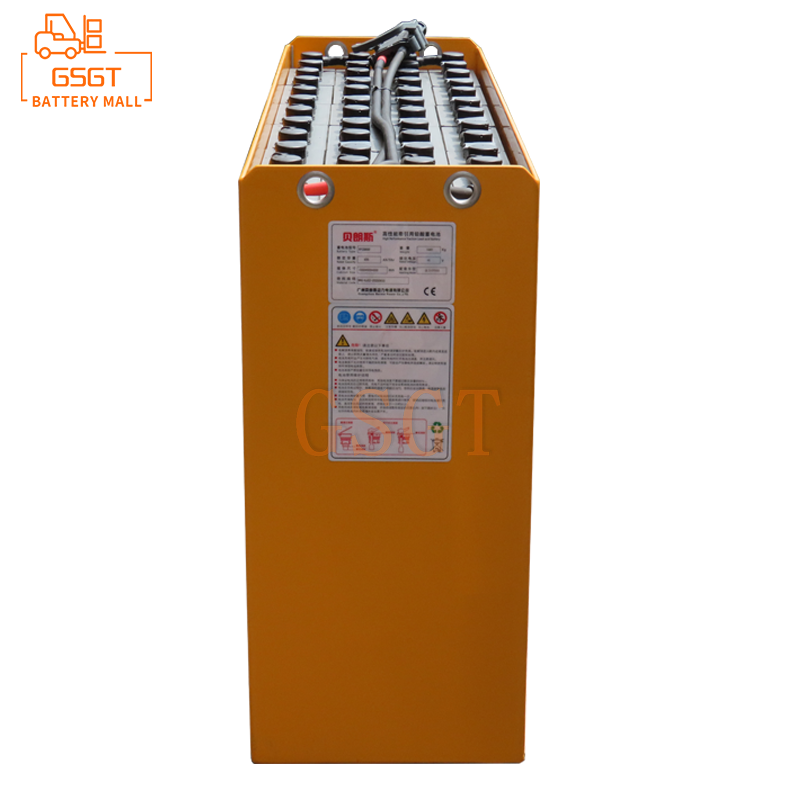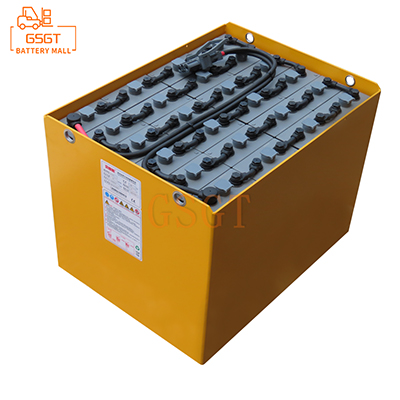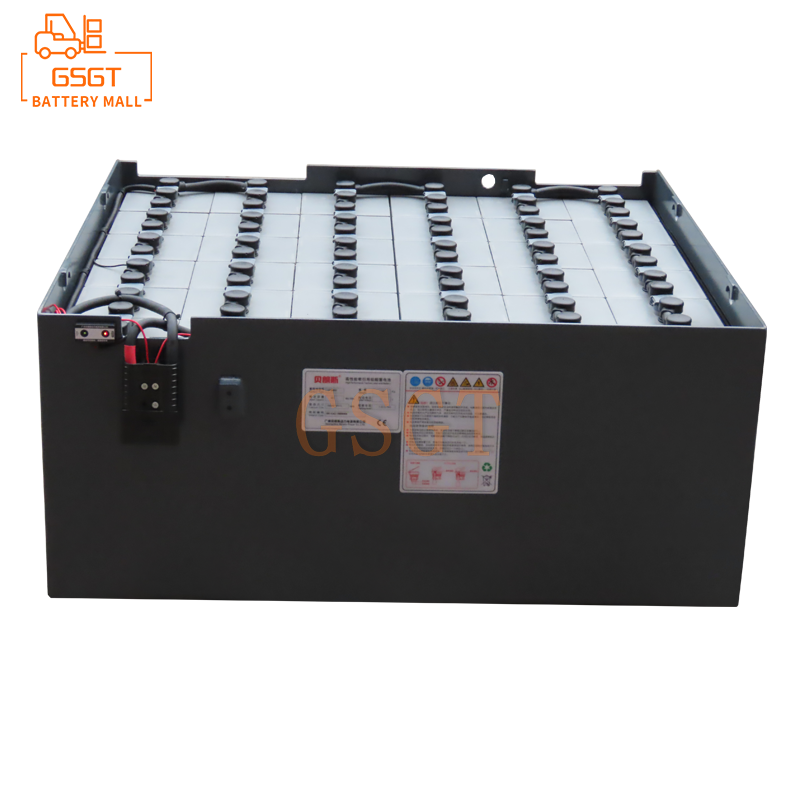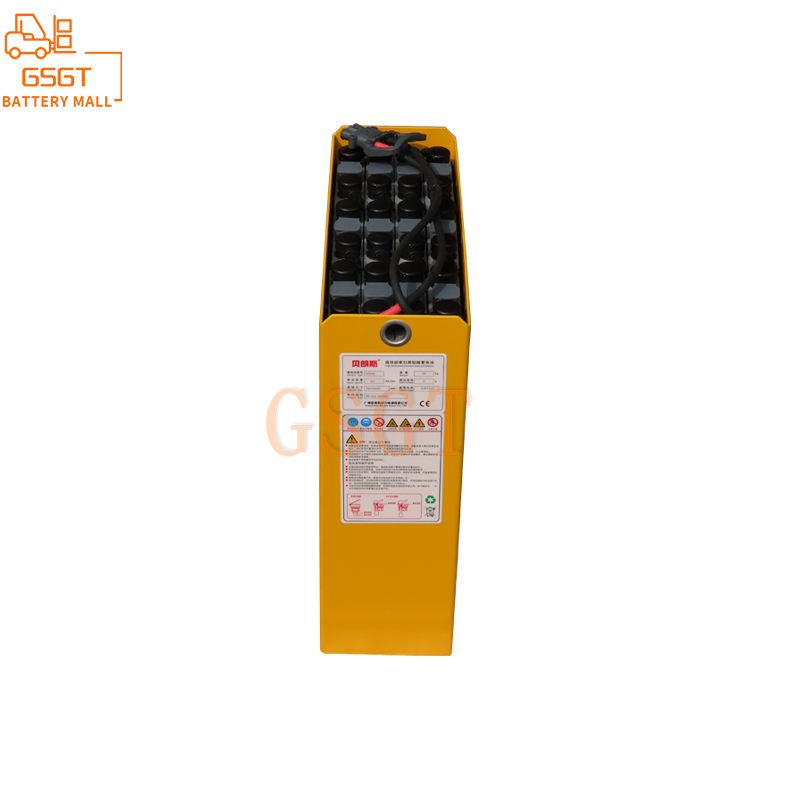Time:2025-04-18 10:37:39
Browse:627
In the industrial field, as an important material handling equipment, the performance and selection of lead-acid batteries, the power source of forklifts, have a profound impact on the operational efficiency, cost control and sustainable development of enterprises. A thorough analysis of forklift lead-acid batteries can provide enterprises with comprehensive and scientific reference basis when selecting equipment, helping them make better decisions.
1. Working Principle and Structural Characteristics of Lead-Acid Batteries for Forklifts
(1) Working Principle
The operation of lead-acid batteries is based on REDOX reactions. During the discharge process, lead dioxide at the positive electrode and lead at the negative electrode react respectively with sulfuric acid in the electrolyte, converting chemical energy into electrical energy to provide power for the forklift. When a forklift is charging, an external power source inputs electrical energy, causing the above reaction to proceed in reverse, achieving the charging of the battery and converting electrical energy into chemical energy for storage. This reversible chemical reaction process is the basis for lead-acid batteries to be repeatedly charged and discharged and continuously provide power for forklifts.
(2) Structural Characteristics
Lead-acid batteries are mainly composed of positive and negative plates, separators, electrolyte, casings and other parts. The positive and negative plates are the core components of a battery. The material, thickness of the plates and the content of active substances directly affect the capacity and performance of the battery. The separator is used to separate the positive and negative plates to prevent short circuits, while allowing ions in the electrolyte to pass through to ensure the smooth progress of electrochemical reactions. The electrolyte is generally a sulfuric acid solution, and its concentration and quality have a significant impact on the charging and discharging efficiency and service life of the battery. The casing serves to protect the internal components and prevent the leakage of the electrolyte. It is usually made of acid-resistant and corrosion-resistant materials.
2. Performance Indicators of Lead-Acid Batteries for Forklifts
(1) Capacity
Capacity is an important indicator for measuring the ability of lead-acid batteries to store electrical energy, and is usually expressed in ampere-hours (Ah). The larger the capacity, the longer the forklift can work continuously after a single charge. When enterprises select models, they need to reasonably choose batteries with appropriate capacity based on the actual working intensity, working hours and load conditions of the forklift. For instance, for forklifts that frequently perform heavy-load operations and have long working hours, large-capacity batteries should be selected to ensure they can meet the work requirements and avoid frequent interruptions due to insufficient power, which could affect production efficiency.
(2) Voltage
The voltages of lead-acid batteries for forklifts usually come in specifications such as 24V, 36V, 48V, 60V, and 80V. Batteries of different voltages are suitable for forklifts of different types and powers. Generally speaking, the higher the voltage, the stronger the power performance of the forklift, which can drive a more powerful motor to achieve a higher traveling speed and a stronger lifting capacity. But at the same time, high-voltage batteries also require more complex electrical systems and higher safety standards. When making a choice, enterprises should comprehensively consider factors such as the working requirements of forklifts, the compatibility of existing electrical equipment, and costs.
(3) Charging and Discharging Performance
The charging and discharging performance is directly related to the usage efficiency and service life of the battery. Good charging performance means that the battery can receive electrical energy quickly and efficiently, shorten the charging time and improve the utilization rate of the equipment. Stable discharge performance ensures that the forklift can continuously and stably output electrical energy during operation, avoiding the impact on the normal operation of the forklift due to excessive voltage fluctuations. The factors affecting the charging and discharging performance include charging current, charging time, and discharging depth, etc. Enterprises should understand the charge and discharge characteristic curves of storage batteries, reasonably arrange charging time and charging methods, and avoid over-discharge and overcharging to extend the service life of storage batteries.
(4) Service life
The service life of lead-acid batteries is influenced by various factors, such as the usage environment, the number of charge and discharge cycles, and maintenance conditions. Generally speaking, under normal usage conditions, the cycle life of lead-acid batteries is about 300 to 800 times. When enterprises select models, they should not only focus on the initial cost of the battery, but also take into account the overall cost throughout its service life cycle. Choosing reliable and long-life batteries, although the initial investment may be relatively high, in the long run, can reduce the frequency and cost of battery replacement and improve the economic benefits of enterprises.
3. Applicable Scenarios of Lead-Acid Batteries for Different Types of Forklifts
(1) Counterbalanced forklift
Counterbalanced forklifts are the most common type of forklift and are widely used in warehouses, ports, factories and other places. Because it needs to undertake heavy cargo handling tasks and has a complex and changeable working environment, it is usually suitable to be equipped with large-capacity and high-voltage lead-acid batteries. For instance, in large logistics warehouses, counterbalanced forklifts need to frequently load, unload and transport goods, with long working hours and high intensity. At this time, batteries with a voltage of 80V and a capacity of over 500Ah can meet their long-term and high-load working requirements, ensuring the continuous operation of the forklifts.
(2) Reach trucks
Reach trucks are mainly suitable for indoor warehouse environments with relatively narrow Spaces, and they have high requirements for flexibility and operational accuracy. Compared with counterbalanced forklifts, the working intensity of reach trucks is relatively low, so lead-acid batteries with relatively smaller capacity and voltage can be selected. Generally speaking, a 36V or 48V battery with a capacity of 200-300Ah can meet the daily operation requirements of reach trucks in indoor warehouses. Meanwhile, the smaller battery size is also more conducive to the operation of forklifts in narrow Spaces.
(3) Electric Stacker trucks
Electric stackers are mainly used for stacking and lifting goods and are usually employed in indoor locations such as warehouses and workshops. Its working feature is that the lifting height is relatively high, but the traveling distance is relatively short. For electric stackers, the appropriate lead-acid battery can be selected based on the lifting height and operation frequency. For electric stackers with a relatively low lifting height and low operation frequency, a 24V or 36V battery with a capacity of 150-200Ah can meet the requirements. For electric stackers with higher lifting heights and frequent operations, it is necessary to select batteries with higher capacity and voltage to ensure sufficient power and endurance.
4. Key Considerations for Selecting Lead-Acid Batteries for Forklifts
(1) Working Environment
The working environment is of vital importance to the selection of lead-acid batteries for forklifts. If the working environment temperature of the forklift is relatively high, it will accelerate the evaporation of the electrolyte and the aging of the plates, reducing the service life of the battery. At this point, batteries with high-temperature resistance should be selected and enhanced heat dissipation measures should be taken. In a low-temperature environment, the capacity of the battery will significantly decrease, and its charging and discharging performance will also be affected. Enterprises need to select batteries suitable for low-temperature environments and take insulation measures, such as installing insulation covers on the batteries. In addition, factors such as the humidity of the working environment and corrosive gases can also affect the battery. Enterprises should choose batteries with corresponding protective performance based on the actual situation.
(2) Cost Factors
Cost is an important factor that enterprises must consider when making a model selection, including initial purchase cost, usage cost and maintenance cost. The initial purchase cost mainly depends on factors such as the brand, capacity and voltage of the battery. Generally speaking, well-known brands, large-capacity and high-voltage batteries are relatively more expensive. The usage cost mainly includes charging expenses and the increased cost caused by the reduced working efficiency of the forklift due to the decline in battery performance. Maintenance costs include expenses such as regular inspections, adding electrolyte, and replacing plates. Enterprises should comprehensively consider these cost factors, select batteries with high cost performance, and achieve effective cost control under the premise of meeting work requirements.
(3) Brand and After-sales Service
Choosing lead-acid batteries from well-known brands for forklifts usually means higher quality assurance and more comprehensive after-sales service. Batteries of well-known brands have stricter production processes and quality control, and their performance and reliability are more guaranteed. At the same time, good after-sales service can promptly solve the problems encountered by enterprises during use, such as providing professional maintenance services and timely replacing faulty batteries, reducing equipment downtime caused by battery failures and improving the production efficiency of enterprises. When choosing a model, enterprises should give priority to brands with a good reputation and a complete after-sales service system.
(4) Compatibility with forklifts
The selection of lead-acid batteries for forklifts must match the model and specification of the forklift. The voltage of the battery should be compatible with the electrical system of the forklift, the capacity should be able to meet the working requirements of the forklift, and the size and weight should be suitable for the battery installation position of the forklift. If the battery does not match the forklift, it will not only affect the normal operation of the forklift, but also may cause damage to the electrical system and mechanical structure of the forklift, increasing the safety hazard. Therefore, when enterprises select models, they should carefully check the technical parameters of the forklift to ensure that the selected battery is perfectly matched with the forklift.
5. Maintenance and Management of Lead-Acid Batteries in Forklifts
(1) Daily Inspection
Daily inspection is an important measure to ensure the normal operation of lead-acid batteries in forklifts. Enterprises should regularly inspect the appearance of storage batteries to check for any leakage of electrolyte or damage to the casing, etc. Check the liquid level of the electrolyte to ensure it is within the specified range. If the liquid level is too low, distilled water or special lead-acid battery replenishment fluid should be added in time. Check whether the connection wires of the battery are firm and whether there is any loosening or oxidation. If there are any problems, they should be dealt with in time.
(2) Charging Management
Reasonable charging management is crucial for extending the service life of batteries. Enterprises should formulate scientific charging plans based on the type and usage of storage batteries. Avoid over-discharging. When the battery's charge drops to a certain extent, it should be charged in time. Generally, it is recommended to charge when the depth of discharge reaches about 70% to 80%. At the same time, the charging current and charging time should be controlled to avoid overcharging. For different types of lead-acid batteries, corresponding charging methods should be adopted, such as constant current charging and constant voltage charging, etc.
(3) Regular maintenance
In addition to daily inspections and charging management, enterprises should also conduct comprehensive maintenance on the lead-acid batteries of forklifts on a regular basis. Regularly perform deep discharge and deep charge on the battery to activate the active substances on the plates, thereby enhancing the capacity and performance of the battery. Check the condition of the plates. If there are problems such as sulfation or softening of the plates, they should be repaired or replaced in time. Clean the dust and dirt on the surface of the battery to keep it clean and prevent short circuits and other faults caused by dust and dirt.
In conclusion, the selection of lead-acid batteries for forklifts is a comprehensive decision-making process involving multiple factors. When enterprises are making a selection, they should have a thorough understanding of the working principle, performance indicators, applicable scenarios and key considerations of lead-acid batteries, and choose the appropriate battery based on their actual needs and working environment. At the same time, strengthening the maintenance and management of batteries can extend their service life, improve the working efficiency of forklifts, reduce the operating costs of enterprises, and provide a strong guarantee for the production and operation of enterprises. Only by doing well in every link during the selection and usage process can the performance advantages of forklift lead-acid batteries be fully exerted and the sustainable development of the enterprise be achieved.

$3810

$3405

$4045

$1270

MESSAGE
Professional And Efficient
Security
Affordable Price
Professional Services